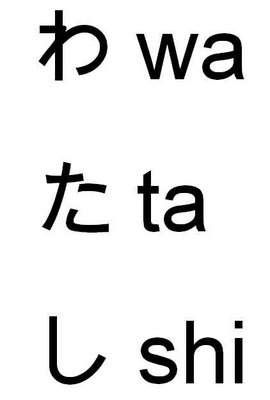This an attempt of mine to share my frugal knowledge on Chinese and Japanese characters. I'm tackling the two, instead of say just Japanese, because for one thing, both languages are linked to each other (or rather it's more proper to say that Japanese is linked to Chinese). Moreover, while there are several books and online webpages there that tackle Chinese and Japanese exclusively, I think it would be more interesting on my part to tackle them both and how they're related to each other.
Japanese has three "alphabets": hiragana, katakana, and kanji (Chinese characters). The first two is pretty much like most of the western languages. Hirigana and katakana act as pronunciation guides, and when we hear certain combination of letters used in conjunction with each other, they form the actual words which we’re familiar with. For example, "I" or "me" in Japanese is watashi. This is usually written in hiragana. It’s when we see the characters of wa, ta, and shi together that we make the mental translation of it meaning "me".

Kanji, on the other hand, doesn’t work that way. There’s no inherent guide on how to pronounce the word. Instead, it’s like signs and symbols. The closest approximation I have for Western culture is that it’s like Egyptian hieroglyphs. Chinese characters are pictograms which convey a certain meaning, depending on the characters used. For example, in Japanese, watashi also has a kanji character. However, it gives readers little insight on how it should be pronounced. However, the advantage of this is that when one is familiar with such characters, it’s faster to comprehend such words. Unlike wa-ta-shi where we process three characters to make sense of a word, the kanji of watashi is simply one character. It’s like seeing a sign on the street: we immediately know what it signifies once we catch a glimpse of it.

The Chinese language only uses kanji. There is no such thing as hiragana or katakana in Chinese. Japanese, on the other hand, can come in hiragana, katakana, kanji, or a combination of hiragana and kanji (there is no mixed combination of katakana and kanji).
Here are other examples of kanji characters: (Pronunciations so far have been in Japanese; the Chinese way of pronouncing them is different, and will be tackled later on.)

No comments:
Post a Comment